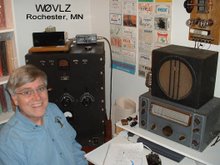
I understand the Maasi people of Tanzania and Kenya have a
rite of passage for boys as they become men. Each must journey into the
wilderness to kill a lion. Up until a few years ago we hams had a rite of passage.
This one dictated by government regulation. Each of us had to journey to the
nearest FCC office to be tested.
Five stressful minutes and five intense seconds...
Six of us were seated around the worn table in the
exam room of the FCC office in San Francisco. The window shades were drawn even
though it was daytime. No fan could dispel the feeling of nervous tension that hung
in the air. I'm sure each of us wanted to be there but we each also wanted the next few
minutes to be over. I was no different from the others. I wanted to pass this
test so that I could advance as a ham. Without a passing tic mark I'm off the
air. To add to the pressure, sitting outside in
the waiting room is Vance, my Elmer and new step-father. He had passed this
same sort of test almost 30 years before. He was good at this and I wanted to
demonstrate that I was good also.
Only the FCC examiner stood. I forget what he looked like. I
was worried about the test, not him, but he had the power of a god. He would
say if I continued with my hobby. He gave the instructions and reviewed the
requirements. I was to demonstrate that I
could copy Morse code sent at 13 wpm. He
had a machine that had the code etched onto paper tape. Once started, his machine
will send this code at exactly 13 wpm for five minutes. It would not stop, slow
down or speed up. To pass I had to copy
any one minute perfectly. One minute of code at 13 wpm, five characters per
word. One minute, 65 characters, in a row, perfectly.
We six each put on our headphones. This was 1967. Ear buds weren't
invented yet. These were "cans", two of them, each covering an ear,
with a metal springy band across the tops of our heads to clamp them in place. Now
I was focused. My world was those cans, my pencil and the government issued lined
tablet in front of me.
The machine started. Focus, focus, di di di dahhh, "V",
that's an "V", write it down. What was the next character? I missed
it. Slow down, wait, you're going too fast. But the machine doesn't wait. One
minute, 65 characters, in a row, perfectly , that's all I need, focus, focus.
The dits and dahs keep coming. I'm hunched over my paper writing as fast as I
can figure out what's being sent. I'm
focused only on the sound in my ears. I see only the tablet in front of me. Suddenly
"ker thunk". It must have been my sweat. Those headphones, slicked by my own nervous
sweat, had slid off my head, falling to the table. Quick, put them back on.
What have I lost? Maybe five seconds? Five or six characters? Start over. One
minute, 65 characters, in a row, perfectly. But in those few seconds, with that
ker thunk, I was finished. I could no longer focus.
I did fail that time but the world didn't end. I had copied enough code to earn my Technician class license. For a while I'd be WA6AVE using a Heathkit Twoer on AM. About six
months later, sitting in the San Antonio FCC exam room (and more comfortable with my ability), I passed the code test. Today CW is my mode of choice.





























